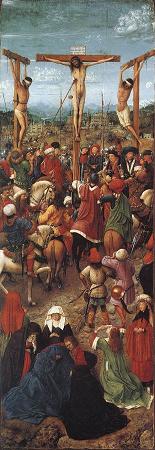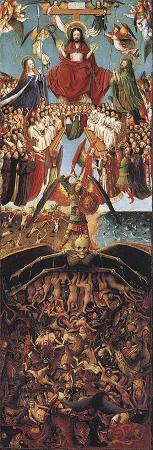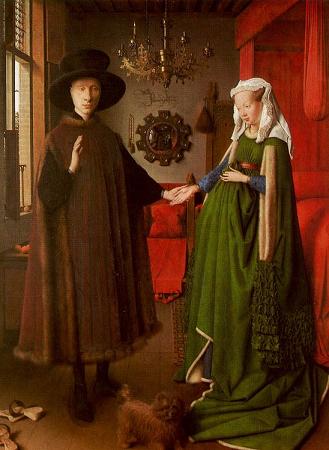Jan van Eyck (c1394 - 1441). Jan van Eyck was a Flemish painter active in Bruges. He is one of the early innovators of what became known as Early Netherlandish painting, and one of the most significant representatives of Early Northern Renaissance art. The surviving records of his early life indicate that he was born around 1380-1390, most likely in Maaseik, in present-day Belgium. He took employment in the Hague around 1422, when he was already a master painter with workshop assistants, and employed as painter and valet de chambre with John III the Pitiless, ruler of Holland and Hainaut. He was then employed in Lille as court painter to Philip the Good, Duke of Burgundy after John's death in 1425, until he moved to Bruges in 1429 where he lived until his death. He was highly regarded by Philip and undertook a number of diplomatic visits abroad, including to Lisbon in 1428 to explore the possibility of a marriage contract between the duke and Isabella of Portugal. About 20 surviving paintings are confidently attributed to him, as well as the Ghent Altarpiece and the illuminated miniatures of the Turin-Milan Hours, all dated between 1432 and 1439. Ten are dated and signed with a variation of his motto, a pun on his name, which he typically painted in Greek characters. Van Eyck painted both secular and religious subject matter, including altarpieces, single-panel religious figures and commissioned portraits. His work includes single panels, diptychs, triptychs, and polyptych panels. He was well paid by Philip, who sought that the painter was secure financially and had artistic freedom so that he could paint whenever he pleased. Van Eyck's work comes from the International Gothic style, but he soon eclipsed it, in part through a greater emphasis on naturalism and realism. He achieved a new level of virtuosity through his developments in the use of oil paint. He was highly influential, and his techniques and style were adopted and refined by the Early Netherlandish painters. Little is known of Jan van Eyck's early life and neither the date nor place of his birth is documented. The first extant record of his life comes from the court of John of Bavaria at The Hague where, between 1422 and 1424, payments were made to Meyster Jan den malre who was then a court painter with the rank of valet de chambre, with at first one and then two assistants. This suggests a date of birth of 1395 at the latest. However, his apparent age in the London probable self-portrait of 1433 suggests to most scholars a date closer to 1380. He was identified in the late 16th century as having been born in Maaseik, a borough of the prince-bishopric of Liege. His last name however is related to the place Bergeijk, due to genealogical information related to the coat-of-arms with three millrinds; that information also implies that he stems from the Lords of Rode. Elisabeth Dhanens rediscovered in the quarterly state the fatherly blazon, in gold, three millrinds of lauric acid, similar to other families that descend from the Lords of Rode in the quarter of Peelland in the meierij van 's-Hertogenbosch. His daughter Lievine was in a nunnery in Maaseik after her father's death.The notes on his preparatory drawing for Portrait of Cardinal Niccolo Albergati are written in the Maasland dialect. He had a sister Margareta, and at least two brothers, Hubert, with whom he probably served his apprenticeship and Lambert, both also painters, but the order of their births has not been established. Another significant, and rather younger, painter who worked in Southern France, Bartholemy van Eyck, is presumed to be a relation. It is not known where Jan was educated, but he had knowledge of Latin and used the Greek and Hebrew alphabets in his inscriptions, indicating that he was schooled in the classics. This level of education was rare among painters, and would have made him more attractive to the cultivated Philip. Van Eyck served as official to John of Bavaria-Straubing, ruler of Holland, Hainault and Zeeland. By this time he had assembled a small workshop and was involved in redecorating the Binnenhof palace in The Hague. After John's death in 1425 he moved to Bruges and came to the attention of Philip the Good c. 1425. His emergence as a collectable painter generally follows his appointment to Philip's court, and from this point his activity in the court is comparatively well documented. He served as court artist and diplomat, and was a senior member of the Tournai painters' guild. On 18 October 1427, the Feast of St. Luke, he travelled to Tournai to attend a banquet in his honour, also attended by Robert Campin and Rogier van der Weyden.
more...













